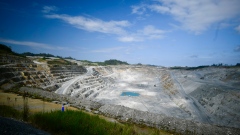Jun 30, 2023
Frozen Russian Central Bank Assets Targeted By EU in New Tax Plan
, Bloomberg News
(Bloomberg) -- European Union leaders are backing plans that would impose a windfall tax on profits generated by more than €200 billion ($217 billion) of Russian central bank assets to aid Ukraine’s reconstruction, and will seek the political support of key Group of Seven countries.
During a summit in Brussels Thursday, EU leaders supported cautiously exploring the windfall option despite the range of complex issues regarding how to use the sanctioned assets, according to people familiar with the talks.
European Commission President Ursula von der Leyen previously said she would present a plan before the summer break, but the timing of the proposal is now unclear given the number of obstacles that still need to be addressed, said the people, who asked not to be identified because the discussions were private.
The Russian central bank assets immobilized in the EU are expected to generate some €3 billion in windfall profits. Over half the assets are in cash and deposits, while a “substantial amount” of the remainder is in securities that will transform to cash as they mature in the next two to three years, Bloomberg previously reported. Many of the funds are in Belgium at settlement giant Euroclear Ltd., where they generated nearly €750 million by the first quarter of this year.
“During this European Council we have discussed the topic of immobilized Russian assets,” von der Leyen told reporters after the summit Friday. “We the commission will come forward with a proposal and we will focus prudently on the windfall profits from the immobilized assets of the Russian central bank.”
A spokesman from the commission declined to comment on the plan.
The prospect of taxing and seizing the windfall profits raises legal as well as financial questions. Several leaders at the summit highlighted concerns first raised by the European Central Bank, which warned that using the proceeds from the assets could encourage official reserve holders to turn their back on the euro, according to the people.
Supporters of the plan have noted that the greater stability risk had been crossed when the central bank assets were blocked in the first place.
As part of those same efforts, the EU will seek support from G-7 countries even though the vast majority of the sanctioned central bank assets are in Europe. That’s because several states want G-7 buy-in as a condition to move ahead, the people said. However, it would likely remain an EU proposal, not a G-7 initiative, another person said.
The EU and US have already been talking about the plans and the Biden administration has been informed of the progress, one of the people said. Discussions with the US and others will continue in the coming days and weeks.
A spokesperson from White House National Security Council declined to comment.
A UK official said Britain was supportive of the EU’s windfall tax plan and talking to the bloc about it.
Legal Hurdles
Politically, the EU’s executive arm will also first want a number of key member states firmly on board, including Belgium and France where most of the assets reside, before presenting a formal proposal.
The EU had previously assessed that a separate option it was considering — setting up an entity to invest the funds and use the proceeds for Ukraine’s reconstruction — was too complex and legally dubious. It has also concluded that seizing the assets outright isn’t possible.
Still, while the windfall option is the least problematic of the ideas that have been explored, there is some legal risk that it could eventually be challenged in court. Some argue that the interest and profits generated from the funds stem from sanctioned assets that ultimately belong to Russia.
A formal proposal for the windfall option would be handled like a foreign policy tool — the same tool under which sanctions get adopted — and would require the backing of all member states to be adopted, the people said.
--With assistance from Jennifer Jacobs and Alex Wickham.
(Updates with European Commission statement in the fifth paragraph.)
©2023 Bloomberg L.P.








